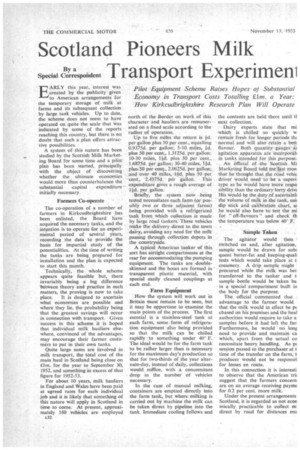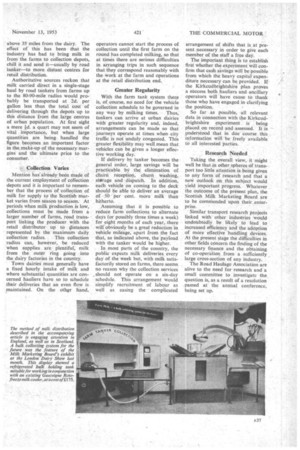Scotland Pioneers Milk Transport Experimeni
Page 138

Page 143

If you've noticed an error in this article please click here to report it so we can fix it.
Pilot Equipment Scheme Raises Hopes of Substantial Economy in Transport Costs Totalling Elm. a Year: How Kirkcudbrightshire Research Plan Will Operate By a Special Correspondent
E
' ARLY this year, interest was created by the publicity given to American arrangements for the temporary storage of milk at farms and its subsequent collection• by large tank vehicles. Up to date, the scheme does not seem to have operated on quite the scale that was indicated by some of the reports reaching this country, but there is no doubt that such a plan offers attrac tive possibilities. • A system of this nature has been studied by the Scottish Milk Marketing Board for some time and a pilot' plan has been started, principally with the object of discovering whether the ultimate economies would more than counterbalance the substantial •capital expenditure initially necessary.
Farmers Co-operate The co-operation of a number of farmers in Kirkcudbrightshire has been enlisted, the Board have acquired the necessary tanks, and the intention is to operate for an .experimental period of several years, recording the data to provide the basis for impartial study of the potentialities. At the time of writing the tanks are being. prepared for installation and the plan is expected to start this month.
Technically, the whole scheme appears quite feasible but, there invariably being a big difference -between theory and practice in such matters, the proving is now to take
place. It is designed to ascertain what economies are possible and where they lie, the probability being that the greatest savings will occur in connection with transport. Given success in this scheme it is hoped that individual milk hauliers elsewhere, convinced of the advantages, may encourage their farmer customers to put in their own tanks.
Quite large sums are involved in milk transport, the tOtal cost of the main haul in Scotland being close on Lim. for the year to September 30, 1952, and something in excess of that figure for 1952-53.
For about 10 years, milk hauliers in England and Wales have been paid at agreed rates for each individual job and it is likely that something of this nature will apply in Scotland in time to come. At present, approximately 160 vehicles are employed e.32 north of the Border on work of this character and hauliers are remunerated on a fixed scale according to the radius of operation.
Up to five mites the return is id. per gallon plus 50 per cent., equalling 0.9375d. per gallon; 5-10 miles, 7,d. plus 50 per cent., 1.3125d. per gallon; 10-30 miles, lid. plus 50 per cent, 1.6875d. per .gallon;' 30-40 miles, 141. plus 50 per cent., 2.0625d. per gallon; and over 40 miles, lid. plus 50 per cent., 2.4375d. per gallon. This expenditure gives a rough average of lid, per gallon:
• Briefly', the system now. being tested necessitates each farm (or pos: sibly two or three adjacent farms)being provided with 'a refrigerated tank from which cellection is made by large road tankers. These vehicles make the delivery direct to the town • . dairy l avoiding any need for themilk passing through collection depots in the countryside.
A typical American tanker of this sort has airtight compartments at the rear for accommodating the pumping equipment. The tanks are doubleskinned and the hoses are formed in transparent plastic material, with special easily cleaned couplings at each end.
Farm Equipment How the system will work out in Britain must remain to be seen, but it may be opportune to examine the main points of the process. The first esential is a stainless-steel tank at each farm, some form of refrigeration equipment also being provided so that the milk can be chilled rapidly to something under 40° F.' The ideal would be for the farm tank to be rather larger than is necessary for the maximum day's production so that for two-thirds of the year alternate-day, instead of daily, collections would Suffice, with a concomitant drop in the number of vehicles necessary.
In the case of manual milking, containers are emptied directly into the farm tank, but where milking is carried out by machine the milk can be taken direct by pipeline into the tank. Immediate cooling follows and
the contents are held there until II next collection.
Dairy experts state that mi which is chilled so quickly w remain fresh for longer periods thi. normal and will also retain a belt flavour. Both quantity gauges at agitation apparatus are incorporati in tanks intended for this purpose. An official of the 'Scottish Mi Marketing Board told rite It mon that he thought that the roa'd vehic dtiver would need to: be -a superi type as he would have More respo sibility than the ordinary lorry drivi His Would be the duty ofaseertaniii the Siolume of milk in the tank, usii dip stick and calibration chart, al he would also have to test the rni for. " off-flavours " and check th the temperature was below 40° F.
Sample Taken The agitator would then Switched on and, after agitation, sample would be drawn for subs talent butter-fat and keeping-quali tests whichwould take place at t creamery. A drip, sample might procured 'while the milk 'was bell transferred to the tanker and t sample bottle would be taken ba in 4 Special. compartment built in the body for the purpose.
The official commented that ; advantage to the farmer would that the milk would in effect be pt chased on his premises and the heal authorities would require to take a: samples before it had left the fan Furthermore, he -would no long need to provide and maintain ea which, apart from the actual en necessitate heavy handling. As pc session passed to the purchaser at t time of the transfer on the farm, t producer would not be responsil for losses en route.
In this connection it is interesti to observe that the American oil suggest that the farmers concern are on an average receiving paymc for 0.2 per cent. more milk.
Under the present arrangements Scotland, it is regarded as not econ mically practicable to ,collect m: direct by road for distances mu above 35 'miles from the dairy. The effect of this has been that the industry has had to bring milk in from the farms to collection depots, chill it and send it—usually by road tanker—to more distant centres for retail distribution.
Authoritative sources reckon that milk carried direct in a single-stage haul by road tankers from farms up to the 80-90-mile radius would probably be transported at 2d. per gallon less than the total cost of delivering through the depots up to this distance from the large centres of urban population. At first sight a mere 4d. a quart may not seem of vital importance, but when large quantities are being handled the figure becomes an important factor in the_make-up of the necessary margins and the ultimate price to the consumer.
Collection Varies Mention has already been made of the current employment of collection depots and it is important to remember that the process of -collection of milk for supply to the Scottish market varies from season to season: At periods when milk production is low, collections must be made from a larger number of farms, road transport linking the producer with the retail distributor up to distances represented by the maximum daily
collection radius. This collection radius can, however, be reduced when supplies are plentiful, milk from the outer ring going into the dairy factories in the countr.y.
Town dairies must generally have a fixed hourly intake of milk and where substantial quantities are concerned hauliers have so to schedule their deliveries that an even flow is maintained. On the other hand, operators cannot start the process of collection until the first farm on the round has completed milking, so that at times there are serious difficulties in arranging trips in such sequence that they correspond reasonably with the work at the farm and operations at the retail distribution end..
Greater Regularity
With the farm tank system there is, of course, no need for the vehicle collection schedule to be governed in any way by milking times. Thus, tankers can arrive at urban dairies with greater regularity and, indeed, arrangements can be made so that journeys operate at times when city traffic is not unduly congested. This greater flexibility may well mean that vehicles can be given a longer effective working day.
If delivery by tanker becomes the general order, large savings will be practicable by the elimination of churn reception, churn washing, shit-age and dispatch. In addition, each vehicle on coming to the deck should be able to deliver an average of 50 per cent. more milk than hitherto.
Assuming that it is possible to reduce farm collections to alternate days (or possibly three times a week) for eight months of each year, there will obviously be a great reduction in vehicle mileage, apart from the fact that, as indicated above, the payload with the tanker would be higher.
In most parts of the country, the public expects milk deliveries_ every day of the week but, with milk satisfactorily stored on farms, there seems no reason why the collection services _should not operate on a six-day schedule. This arrangement would simplify recruitment of labour as well as easing the complicated arrangement of shifts that is at present necessary in order to give each member of the staff a free day.
The important thing is to establish first whether the experiment will confirm that cash savings will be possible from which the heavy capital expenditure necessary can be provided. If the Kirkcudbrightshire plan proves a success both hauliers and ancillary operators will have cause to thank those who have engaged in clarifying the position.
So far as possible, all relevant data in connection with the Kirkcudbrightshire experiment is being placed on record and assessed. It is imderstood that in due course this information will be freely available
to all interested parties. .
Research Needed Taking the overall view, it might well be that in other spheres of transport too little attention is being given to any form of research and that a new outlook on this subject would yield important progress. Whatever the outcome of the present plan, the Scottish Milk Marketing Board are to be commended upon their enterprise.
Similar transport research projects linked with other industries would undoubtedly be likely to lead to increased efficiency and the adoption of more effective handling devices. At the present stage the difficulties in other fields concern the finding of the necessary finance and the obtaining of co-operation from a sufficiently .. large cross-section of any industry.
The Road Haulage Association are alive to the need for research and a small committee to investigate the question is, as a result of a resolution passed at the annual conference, being set up.












































































































































































































































